Erro: The request client is not a secure context and the resource is in more-private address space local
Solução:
Digite chrome://flags/ na url do navegador e altere a flag “Block insecure private network requests.” de “default” para “Disabled”.
Erro: The request client is not a secure context and the resource is in more-private address space local
Solução:
Digite chrome://flags/ na url do navegador e altere a flag “Block insecure private network requests.” de “default” para “Disabled”.
When downloading files by Google Chrome from some websites, it has the error: virus scan failed. And the file is prevented from being opened.
Solution:
Open regedit
Find the path:
HKEY_LOCAL_MACHINE\SOFTWARE\Microsoft\Windows\CurrentVersion\Policies\Attachments
Change value ScanWithAntiVirus to 1
Ao baixar arquivos pelo Google Chrome de alguns sites o mesmo apresenta o erro: falha na verificação de vírus. E o arquivo é impedido de ser aberto.
Solução:
Abrir o regedit.
Localizar o caminho HKEY_LOCAL_MACHINE\SOFTWARE\Microsoft\Windows\CurrentVersion\Policies\Attachments
Alterar o valor do item ScanWithAntiVirus para 1.
Hoje, o certificado DST Root CA X3 expirou, deixando muitos dispositivos na Internet com problemas para se conectar a serviços e certificados que usam essa CA raiz, incluindo aqueles que usam certificados Let’s Encrypt.
Alguns desses dispositivos problemáticos incluem telefones Samsung Galaxy, iPhones, VDI zero e thin clients e até mesmo firewalls Sophos UTM.
No meu ambiente, notei uma série de problemas ao navegar em sites que usam os certificados gratuitos Let’s Encrypt, incluindo e-Social e alguns serviços do governo, pois o serviço Web Protection Web Filtering em meu firewall Sophos UTM relataria que o certificado expirou e não me permite acesso aos sites que o usam .
O PROBLEMA
Let’s Encrypt originalmente usou o certificado “DST Root CA X3” para emitir certificados Let’s Encrypt. No entanto, à medida que o tempo passou e o serviço não foi mais usado, eles agora usam “ISRG Root X1” e “ISRG Root X2” como CA de raiz e “Let’s Encrypt R3” como um certificado intermediário.
Dispositivos mais antigos podem estar usando a CA Root mais antiga, que expirou hoje (30 de setembro de 2021). Consulte https://letsencrypt.org/docs/dst-root-ca-x3-expiration-september-2021/ para obter mais informações.
SOLUÇÃO
Para corrigir esse problema, você precisa adicionar as 2 novas CAs raiz ao seu computador ou dispositivo.
Certificados de CA raiz (formato PEM):
ISRG Root X1 (ou ISRG Root X1 DER Format)
ISRG Root X2 (ou ISRG Root X2 DER Format)
Certificado Intermediário (PEM format):
Let’s Encrypt R3 (Or Let’s Encrypt R3 DER Format)
Você pode baixá-los clicando nos links acima ou ir para https://letsencrypt.org/certificates/ para mais informações e fazer o download, se você não confiar nos links acima.
Depois de baixar e adicionar essas CAs raiz e a CA intermediária ao seu computador ou dispositivo, você deve ter toda a cadeia de certificados para validar os certificados do Let’s Encrypt. Os certificados Let’s Encrypt que são usados em sites que você visita e que você pode ter implantado em seus servidores agora devem funcionar sem problemas.
Se ainda estiver tendo problemas, você pode tentar excluir o certificado “DST Root CA X3” de suas CAs raiz existentes. Além disso, pode ser necessário fechar e reabrir qualquer software e / ou navegador para que funcione com o novo certificado.
Correção do firewall para verificação / filtragem de HTTPS (Sophos UTM como exemplo)
Se você tiver um firewall que verifica o tráfego HTTPs, precisará adicionar os certificados acima à lista de autoridade de certificação HTTPS.
Por exemplo, para corrigir isso no firewall Sophos UTM, siga as instruções abaixo:
Baixe os 3 certificados acima.
Faça logon no seu Sophos UTM
Navegue até a guia “Web Protection”, “Filtering Options” e “HTTPS CAs”.
Desative o antigo certificado “Digital Signature Trust Co. DST Root CA X3” na lista.
Usando “Carregar CA local”, navegue até e selecione 1 dos 3 certificados e clique em carregar.
Repita a etapa 5 para cada um dos 3 certificados listados acima.
O problema foi corrigido! Agora você deve ver todos os 3 certificados na lista “CAs de verificação local”.
As etapas devem ser semelhantes para outros firewalls que fornecem varredura e filtragem HTTPS.
Today, the DST Root CA X3 certificate expired, leaving many devices on the internet having issues connecting to services and certificates that use this Root CA, including those using Let’s Encrypt certificates.
Some of these problematic devices include Samsung Galaxy phones, iPhones, VDI zero and thin clients, and even Sophos UTM firewalls.
In my environment, I noticed a number of issues when browsing to websites that use the free Let’s Encrypt certificates, as the Web Protection Web Filtering service on my Sophos UTM firewall would report the certificate has expired and not allow me access to the websites using it.
Let’s Encrypt originally used the “DST Root CA X3” certificate to issue Let’s Encrypt certificates. However, as time has passed and the service has been used more, they now use “ISRG Root X1” and “ISRG Root X2” as Root CA’s and “Let’s Encrypt R3” as an intermediate certificate.
Older devices may be using the older Root CA which expired today (September 30th, 2021). Please see https://letsencrypt.org/docs/dst-root-ca-x3-expiration-september-2021/ for more information.
To fix this issue, you need to add the 2 new Root CAs to your computer or device.
Root CA Certificates (PEM format):
Intermediate Certificate (PEM format):
You can download them by clicking the links above or go to https://letsencrypt.org/certificates/ for more information and to download if you don’t trust the above links.
After downloading and adding these Root CAs and the Intermediate CA to your computer or device, you should have the full certificate chain to validate the Let’s Encrypt certificates. The Let’s Encrypt certificates that are used on websites that you visit and that you might have deployed on your servers should now work without any issues.
If you’re still having issues, you can try deleting the “DST Root CA X3” certificate from your existing Root CAs. Also, you may need to close and reopen any software and/or browsers for it to work with the new certificate.
If you have a firewall that scans HTTPs traffic, you’ll need to add the above certificates to the HTTPS Certification authority list.
As an example, to fix this on the Sophos UTM firewall, follow the instructions below:

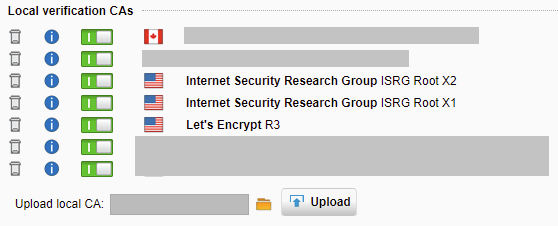
The steps should be similar for other firewalls that provide HTTPS Scanning and Filtering.
The issue happened out of the bat mid December and I didn’t know what to do. I managed to resolve it and this thread is to share my experience because this took me several hours of research.
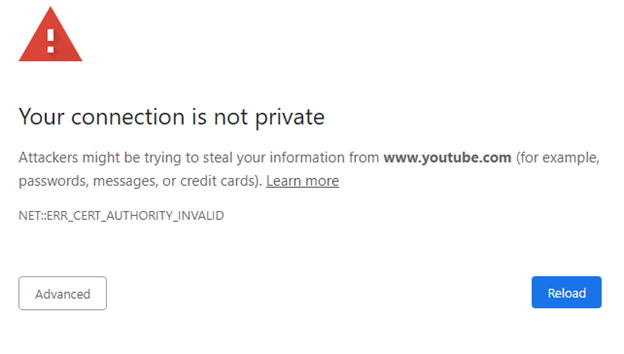
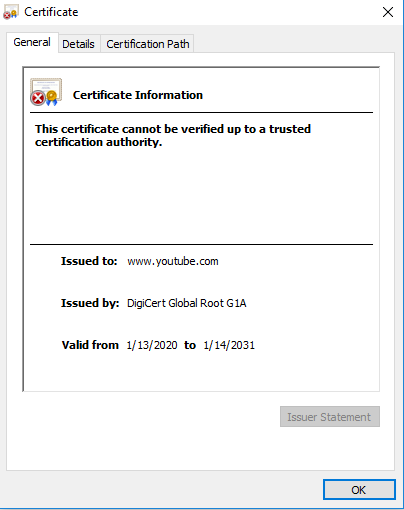
The certificate is invalid for both websites. Issued by DigiCert Global Root G1A.
Issue existed before reinstalling the Windows and reappeared after I switched the motherboard, processor and RAM of the machine as well ass reinstalled the Windows, which makes it a new machine. The websites were working fine right after I reinstalled Windows, but the issue reappeared after a few days after a restart of the machine.
Resolution:
Before the start I ensured Time and Date were correct and triple checked them as this could cause issue.
After some digging on the DigiCert Global Root G1A issued certificates I found this link – https://support.mozilla.org/en-US/questions/1286644 – where Chrome was not loading Google or captchas (I had the issue with the captchas and YouTube originally) and although the issue was slightly different – “SSL_ERROR_BAD_CERT_DOMAIN”, the person was given settings how to disable Proxy usage for Firefox. I installed Firefox (previously tried with Opera, Edge, IE, Chrome) and disabled the usage of a proxy from Windows 10 and to my surprise the websites started opening without issues.
This discovery led me to the idea that Windows 10 is using a proxy by default (because I did not set up such) and started looking for ways to disable it. I was not able to change the settings via Internet Options – LAN settings as they were grayed out.
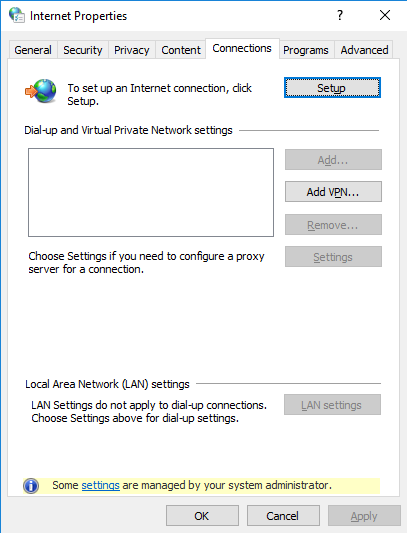
Windows 10 was opening other proxy settings though, however I was not able to disable automatic proxy from there as there was no “Save” option – it was grayed out.
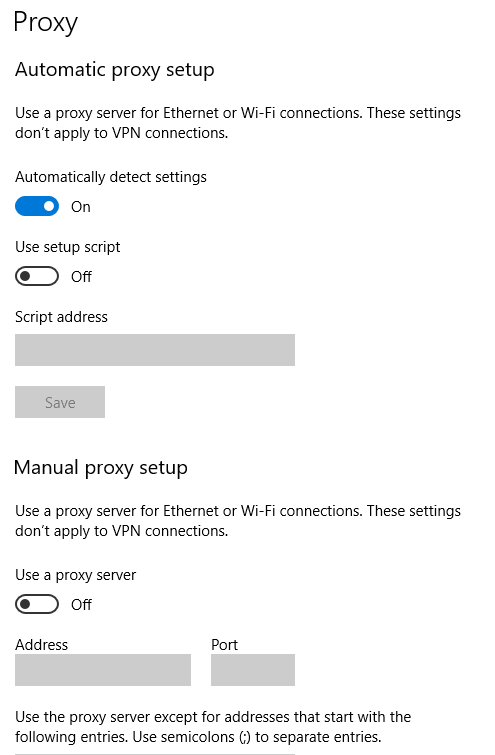
I started thinking I was stupid as the system cannot be using proxy or I am not doing something right, and proceeded searching for other methods of disabling the proxy in Windows 10, when I found this thread – https://answers.microsoft.com/en-us/windows/forum/windows_10-other_settings-winpc/how-to-disable-proxy-on-windows-10/02cf6980-2b5c-4ac9-aa25-4a61f26375e9.
This is the solution that was proposed inside:
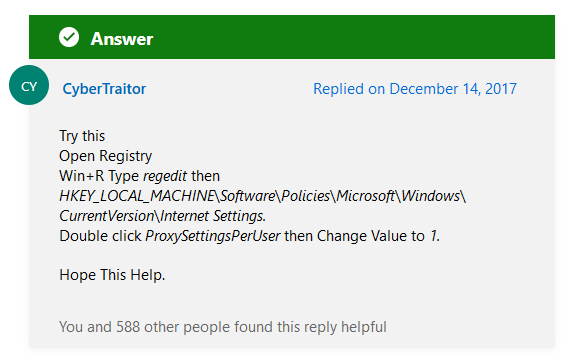
I opened the registry path Computer\HKEY_LOCAL_MACHINE\SOFTWARE\Policies\Microsoft\Windows\CurrentVersion\Internet Settings and changed the ProxySettingsPerUser to 1.
IT WORKED!
This time the certificates were coming from GTS CA 1O1 for YouTube. This was one of the strangest issues I have ever researched.
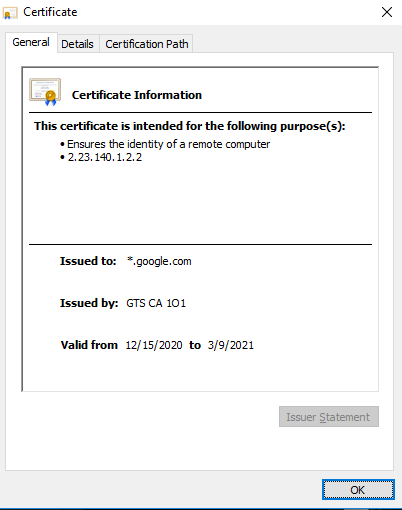
Final words:
Not sure if this happened because of the issues in December. I heard some certificate originators were blocked. Do you have any ideas what could have caused this issue on a brand new machine and Win10? I am opened to questions.
Tor must have been working because it is using a proxy of its own.